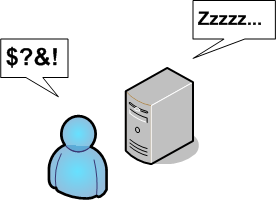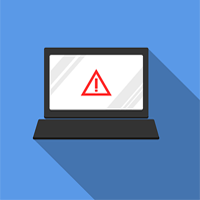No Time for Downtime in Web Hosting

 Technology is imperfect. Of course, I'm not telling you anything you didn't already know, as surely everyone who works on the Web has, at one time or another, had to deal with some sort of technological blunder. Undoubtedly, one of the biggest problems that websites of all shapes and sizes fear the most is downtime.
Technology is imperfect. Of course, I'm not telling you anything you didn't already know, as surely everyone who works on the Web has, at one time or another, had to deal with some sort of technological blunder. Undoubtedly, one of the biggest problems that websites of all shapes and sizes fear the most is downtime.
Unplanned downtime occurs when a network or server goes offline or becomes unavailable for a period of time as a result of a hardware, software, equipment or transmission failure, or when a system reaches capacity unexpectedly. Frequently, this results in a website (or sites) temporarily going offline. As we all know, time is money, and downtime can often wind up being very costly for a Web business.
At other times, it is necessary for a Web hosting service to induce downtime for maintenance and/or updates, but unfortunately this also leads to websites being temporarily inaccessible. On the upside, there are some precautionary measures that site owners can take to avoid, or at least dramatically minimize, downtime and the negative effects it can have on a business.
Avoiding Downtime
The most common method many website owners use for avoiding downtime is website monitoring, a process that tests (and verifies) a website or Web application to ensure that it is fully functioning for the end user. These services will alert site owners anytime a problem occurs, allowing them to take the necessary steps to get it resolved in a timely manner.
These services will check on a website at predetermined intervals (usually 30 minutes or an hour) to see if everything is working properly. Best of all, they can act as visitors from various geographic locations and Internet connections; so owners can feel comfortable knowing everyone has access to their site.
In the name of simplicity, site owners can simply make sure that they choose a Web hosting provider that also offers website monitoring services as part of their package. However, there are also plenty of third-party services around the Web that will conduct website monitoring practices for a reasonable price (and often times totally free of charge). Some of these services include SiteUptime, WatchMouse, Observu, Site24x7 and Montastic, among many others.
One other thing that site owners can do to circumvent the issue of downtime is simply to choose wisely when selecting a Web hosting provider. Many services will offer specific uptime guarantees, and by simply doing some research, owners can find out which of these companies live up to their promises.
Switching Hosting Providers
Without taking precautions, many website owners could face sever downtime issues when they switch hosting providers. This is an easy problem to avoid. The biggest concern is making sure you've transferred all of your website information over to the new server before you change and point your domain name server (DNS). Only go to your registrar and initiate the name change after successfully moving your information. Also, make sure you monitor the domain name change by staying in contact with your registrar, and be aware of any problems that may occur.
Minimizing the Impact of Downtime
No matter how much we may not like it, the fact is that sometimes downtime happens, despite all of the preventative measures that site owners and hosting providers may take. This is why it is important for all parties involved to have a plan in place for minimizing the impact this downtime will have the businesses of the site owners. If you run a website, this means staying informed about the situation and relaying the information to your customer base.
As soon as a problem occurs (or, more accurately, as soon as an owner hears about it), the first step is to get in contact with the hosting provider. They should find out the cause of the downtime and get an estimate on how long it will take to correct the problem.
After that, they have a responsibility to their customers to inform them of the situation, and doing so will show them that businesses are taking an active role in trying to improve the situation and concerned with their user experience. This can be difficult to do, but it is much easier these days than in years past.
One effective way to share this information with an audience is for a company to send out an email to all of its email lists with information about why the site is down and how long it may be before it will be back up. In addition, posting updates about the site during downtime on social networks like Facebook and Twitter is another great way to keep users informed.
Another option is to create a maintenance window, which shows up when users try to visit your site during downtime, which is a special page that explains the situaton in a friendlier, more informative way than a typical error message. Not all hosting services offer these, and they're much easier to pull off during planned downtimes because they can be prepared in advance, but they're very useful for those visitors who aren't on a company's email lists or involved with them on social media.
Of course, with enough proper planning, a company could utilize all of these methods to help quell any problems that may arise during downtime.
For now, downtime is still and issue that many website owners will have to deal with, but thankfully a little forethought and gumption can ease the negative effects of downtime and make life much easier for Web workers.









